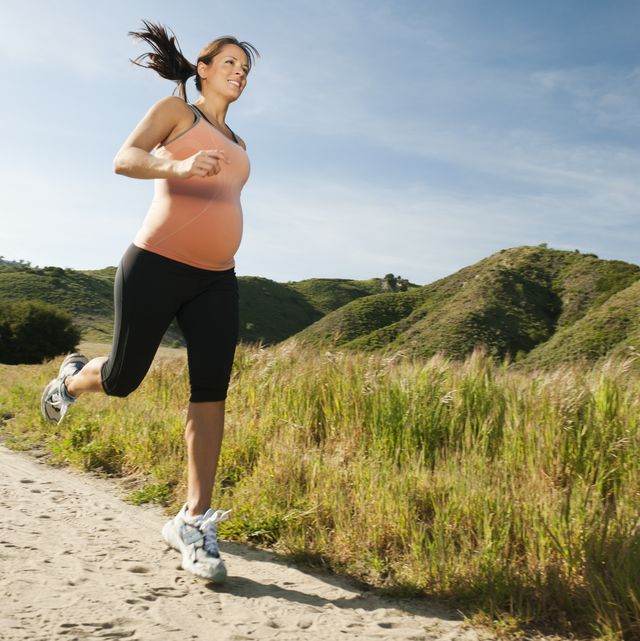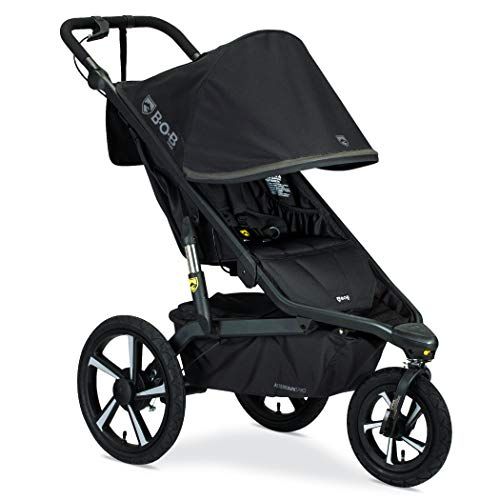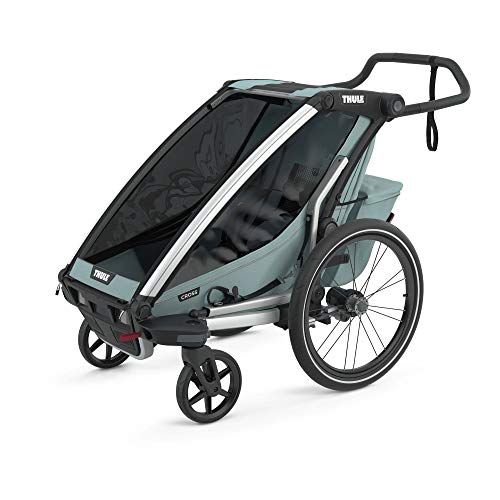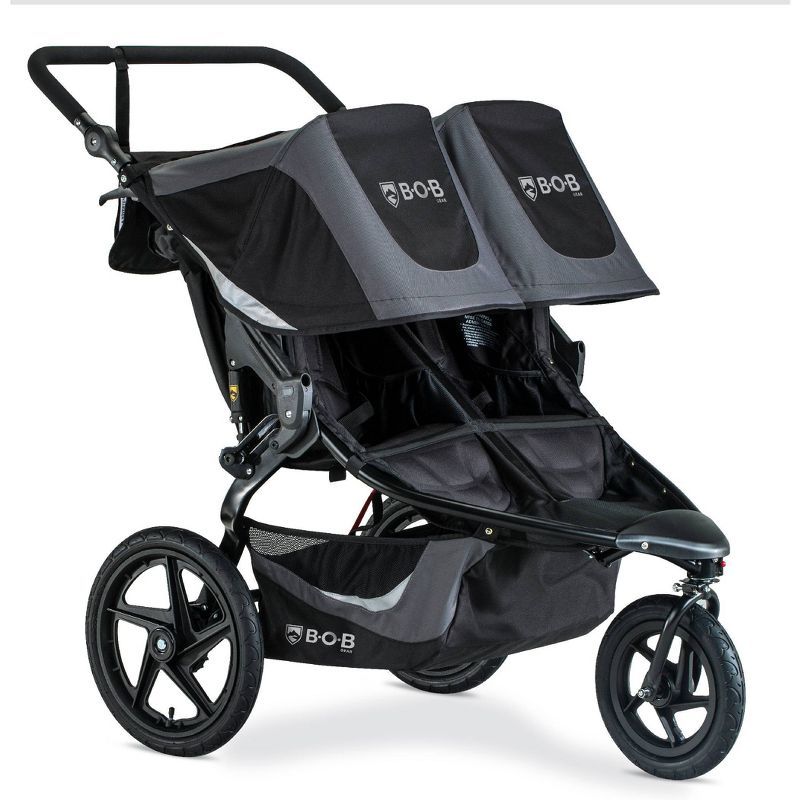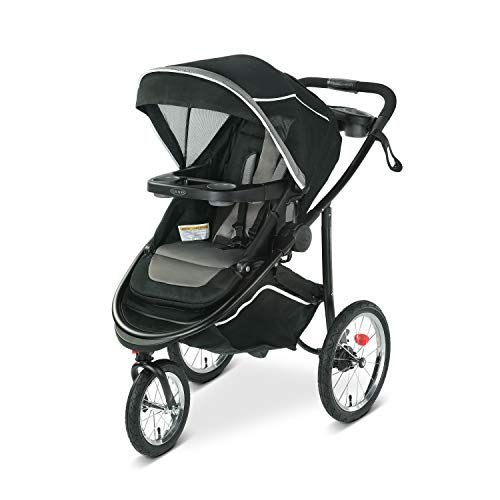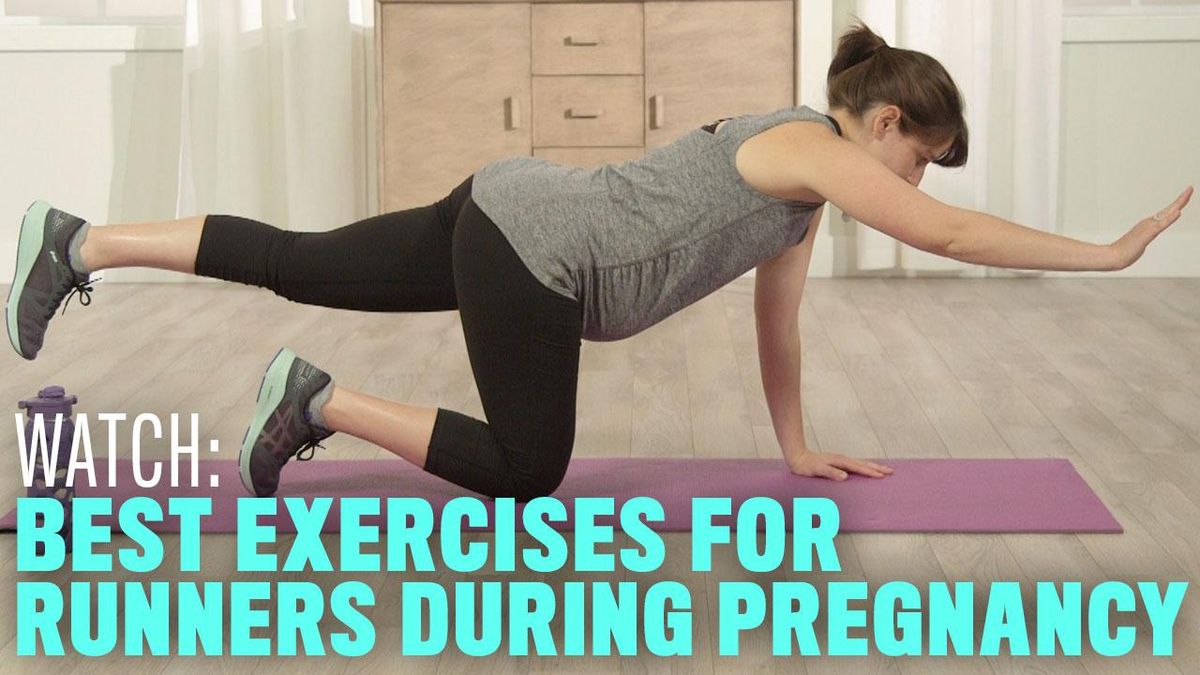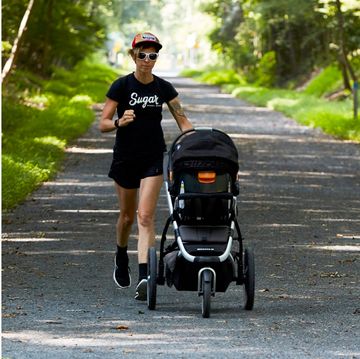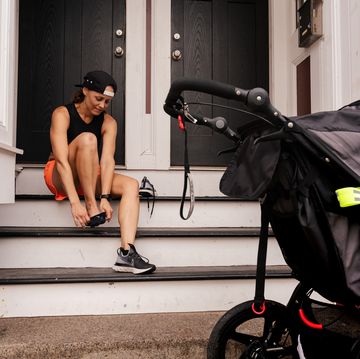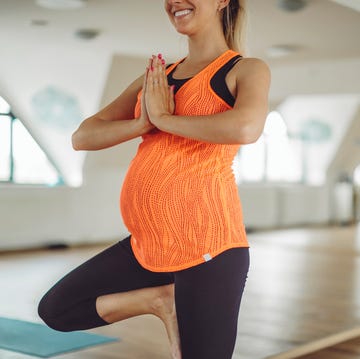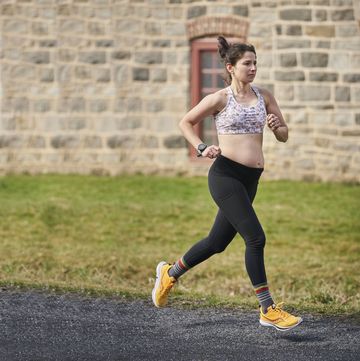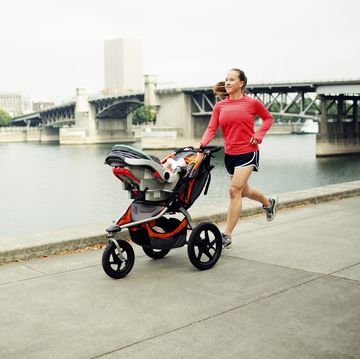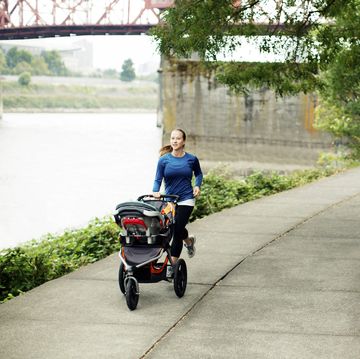While keeping you and your little one safe during pregnancy is top priority, you don’t need to hang up your running shoes for nine months to do so. According to experts, you can run while pregnant—it’s safe for both you and your unborn child. You just might need to make some adjustments.
Having hesitations about exercising while you’re expecting is completely normal, though. In this guide, we explain everything you need to know about running while pregnant, including how to stay safe and maintain comfort, and what steps you should take when you want to the sport postpartum.
What are the benefits of running while pregnant?
The American College of Obstetricians and Gynecologists (ACOG) recommends exercise throughout pregnancy, as long as you’re not high risk and get clearance from your doctor. The ACOG suggests 150 minutes of moderate-intensity activity per week, which you can break up into 30-minute workouts five days a week, 10 minutes a couple times a day, or whatever works best for you.
Exercising through your pregnancy may lower the risk of gestational diabetes, preeclampsia (pregnancy-induced high blood pressure), early delivery, and the need for a cesarean section. It may also improve your baby’s brain development.
Plus, as many of us know, running can make you feel better and relieve anxiety. And despite some rumors, it won’t put you into labor—although it can help get you through it. “Women who exercise [during pregnancy] have easier, faster labors, they feel better postpartum, and their recovery is much quicker,” says Erin Dawson Chalat, M.D., an OB-GYN and runner in Maine.
Research backs up the benefits of running while pregnant: A study published in the American College of Sports Medicine’s Health & Fitness Journal found that engaging in physical activity during pregnancy reduces the odds of developing depression by 67 percent and reduces the severity of depressive symptoms. At the same time, increasing the amount of weekly exercise you get reduces the odds of developing pregnancy-related complications, per the research.
The catch is that if you weren’t a runner before getting pregnant, it can be a challenging time to start. “There are so many body changes—your center of gravity is off, it doesn’t feel that good,” Dawson says. She recommends starting with strength-building and getting cardio from the elliptical or stair climber first. And as with any form of exercise, you should always consult with your doctor before implementing a new routine.
What precautions should I take when running while pregnant?
If complications in your pregnancy arise—such as bleeding, placental problems, or preeclampsia—running can be risky. Having multiples might also put you at risk for premature labor and make running while pregnant a no-go.
But for those with uncomplicated pregnancies, experts say there’s no harm in maintaining your exercise routine; running won’t cause miscarriage or hurt the baby. “The baby is pretty isolated and protected during pregnancy,” Dawson says.
Keep in mind, you may start sweating earlier and faster, so be sure to hydrate well and wear loose-fitting clothing. It may be best to move indoors on hot or humid days, particularly in the first trimester when a high body temperature (above 102 degrees) may cause neural tube defects, although ACOG says it’s unlikely exercise will increase body temperature to a dangerous level. However, hot yoga, hot tubs, and saunas should be avoided, because they can quickly raise your body temperature above 102 degrees.
Be careful on uneven surfaces as your center of gravity changes. Concentrate on good form while running and when strength training. The body produces the hormone relaxin, which loosens ligaments during pregnancy. Relaxin acts all over the body, but has its most profound effects in the pelvis (so the baby can make its way out). Loose ligaments can cause pain in the pelvis, sacroiliac joint, or lower back and make you feel extra sore after a run. You may also be more prone to injury because looser ligaments aren’t as stabilizing.
The ACOG says going off of perceived exertion and keeping a conversational pace is a smarter way to go than monitoring your heart rate. “If you can talk and feel okay, you can continue,” Dawson says.
How will pregnancy affect my run performance?
Accept that your running will change. “You’re going to get slower, and that’s a given,” says Julie Levitt, M.D., an OB-GYN and marathoner in Chicago. “But you may be able to spend the same amount of time active, you just won’t cover as much ground.” While ACOG suggests 30 minutes of activity, Levitt says it can be an hour or longer if you feel up to it.
But it’s not the time to push yourself: Slow down, add walk breaks, or take extra recovery days as needed. “Give yourself some grace,” says Lindsey Hein, a run coach, podcaster, mother of four, and runner in Indianapolis. “Don’t hold yourself to a certain standard. Get started, see how it feels, and go from there.”
Keep in mind, you’ll maintain fitness even if you cut back, as your body is working plenty hard on its own—boosting both blood volume and heart capacity. “You’re kind of getting super fit for your baby,” says Nadya Swedan, M.D., a physical medicine and rehabilitation specialist and author of The Active Woman’s Health and Fitness Handbook. “If you do half of what you were doing before, you’re probably going to end up at the same level of fitness when it’s all over.”
In fact, if you run with a Garmin smartwatch to log your miles, the Garmin Connect app has a pregnancy tracking feature that allows you to enter pregnancy-related symptoms, track baby movement, create customizable reminders (like when to drink water), and receive exercise and nutrition tips to keep you running strong and in the know about how your fitness ebbs and flows throughout your pregnancy.
Something else to note: Thanks to increased pressure on your bladder, you may need to find new routes with places to stop and pee. Just don’t try to avoid bathroom breaks by cutting back on fluids; proper hydration is a must for the health of you and your growing baby. You may need more water than usual, but if your urine is clear, you’re having too much, Levitt says. “Go for the pale yellow color and the feeling of satiation,” she says.
Eat easily digestible carbohydrates before running but give yourself extra time after eating before running because digestion may slow down in pregnancy. When you return, replenish with protein and electrolytes.
Can I run a race while pregnant?
If you were training for a race before you got pregnant, consult with your doctor about the best plan of action moving forward. If you decide to run a race, keep in mind that you may find yourself running slower than your normal pace—and that’s okay!
Whether or not you run the race should be decided by you and your doctor. If you decide it’s not the best option for you and the baby, you can always run a celebratory race after giving birth.
Will I be able to run through every trimester?
For some, the first trimester is the hardest, thanks to the nausea and exhaustion. Both Dawson and Levitt say that running while pregnant may help you feel better. Of course, if you haven’t been able to keep any food down, it’s probably best not to run, Swedan says.
But the second trimester can be the “pregnancy honeymoon,” as nausea subsides and energy returns. After minimal running in the first trimester, Lindsay O’Brien, a former All-American at Yale and mother, increased her mileage in the second.
Still, as the body stretches and ligaments loosen to accommodate the growing baby, there may be some new pains. You may experience sacroiliac pain, pain in the lower back that may radiate down one side, or round ligament pain, a sharp pain or dull ache in the lower abdomen. Having a strong core can prevent or lessen sacroiliac pain, and a belly band may help with round ligament pain.
Keep checking in with yourself and your doctor throughout your pregnancy to determine whether running is right for you in that stage of the journey.
When should I stop running while pregnant?
When the third trimester hits, many runners find they need to stop. “The first week of my third trimester, everything stopped running-wise,” O’Brien says. She had completed a 7-mile run a few days earlier but suddenly couldn’t run at all due to back and pelvic pain.
In her first two pregnancies, Roxanne Lorenz, a mother of three in Minnesota, got to a point where she just didn’t have the desire to run anymore. “Mentally, I was ready to be done,” she says.
A study of 110 competitive runners found that while 70 percent of those surveyed ran during their pregnancy, only 31 percent ran during the third trimester.
However, there are exceptions and some people can run through their entire pregnancy. In 2014, Lorenz started a running streak and didn’t break it during her third pregnancy. Eliza Miron, a streaker for more than a decade, also ran through her pregnancy.
To keep their streaks, both had to run at least one mile every day—including the day of delivery and the day after. Miron, who gave birth at home, did a slow jog five hours later with her husband at her side. Lorenz ran very slowly on a treadmill the morning she went into labor, delivered that afternoon, and ran laps around her hospital room the next evening. (Note: It’s important to get clearance from your doctor after giving birth and before exercising. Most doctors will suggest taking at least six weeks off post-delivery before you start working out again.)
Both Miron and Lorenz were willing to give up their streak if any complications arose or a cesarean section was necessary. “Obviously if it didn’t work out, I’d rather have a healthy baby than make sure I got in my run,” Miron says.
For the rest of us, Hein offers the more forgiving outlook she’s gained after running through multiple pregnancies. “By the time I got to my third pregnancy, I was just like, ‘Let it go.’ If you feel good, and you want to run, go run. If you don’t, don’t,” she says.
O’Brien agrees and says to not put too much pressure on yourself. “I figured if I sweat every day or got in a little bit of activity every day, it’s good for me, and it’s good for the baby—even if it’s 10 minutes around the neighborhood or a little spin on the stationary bike.”
When should I return to running postpartum?
After your bundle of joy arrives, it may be weeks before you’re allowed to run. Although some experts say returning sooner may be okay, others recommend waiting to get cleared at your six-week postpartum checkup. “Your tendons and ligaments do remain a little bit relaxed and a little bit soft and injury prone until you’re further out,” Levitt says. If you feel good before that, go for a walk, try the elliptical, or do some light strength training.
If you want to work your core, Swedan suggests doing five minutes of planks and bridges every day rather than longer sessions less often. But Dawson says not to stress about it. “Lifting the car seat with the baby in it takes a fair amount of core strength—a lot of twisting, a lot of oblique work—so just having a baby is pretty good exercise,” she says. But for issues like diastasis recti (abdominal separation) or urinary incontinence, see a specialist for recommendations and exercises.
Be patient and don’t expect too much too soon. Like coming back from an injury, you’ll need to slowly build back up. “Take it easy on yourself. There’s so much going on, hormones and demands on your body,” O’Brien says.
Not only has your body been through a lot, you’re probably not sleeping and breastfeeding can sap your energy even more. If you nurse, make sure to stay hydrated, get enough calcium and vitamin D, and wear a supportive sports bra (possibly in a larger size) when exercising.
When things do start clicking again, you might discover an extra edge you didn’t have pre-pregnancy. “I definitely feel a lot stronger from going through the whole pregnancy and delivery,” says Desirae Piccoli, a New Jersey runner who gave birth in 2016. “My pain tolerance is a lot higher.” Another example: Hein set a marathon PR nine months after having her first child.
Lorenz has also gotten faster with each pregnancy. “I just keep thinking, ‘If I can make it through labor, I can make it through this race.’”
No matter how you feel about running while pregnant or after delivery, just do what’s best for you, and give yourself some grace if you need extra time to recover.
